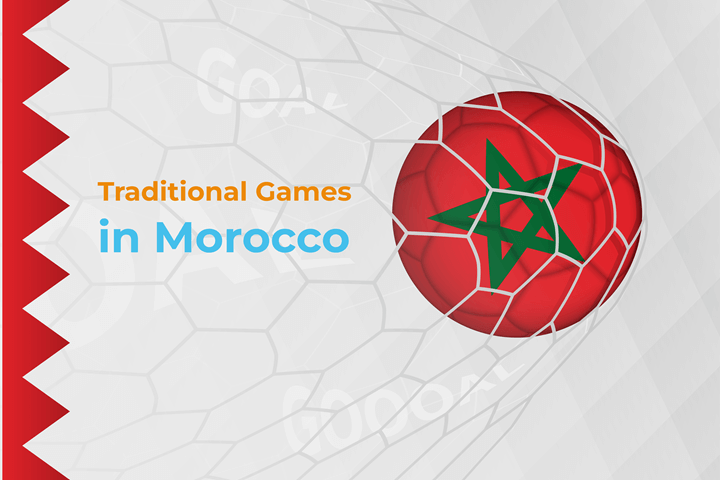Traditional games in Morocco are an integral part of the country’s rich cultural heritage. These games are not merely a means of entertainment; they are also schools for teaching social values and physical and mental skills. By exploring these games, Arabic language learners can gain a deeper understanding of Moroccan society and its history.
Moroccan Games: Challenges for the Mind
- As-Sik (السيك):
- Description: This is a very popular Moroccan game, especially in the Moroccan Sahara. People also call it « the camel game. » It’s played on a board drawn on the ground or sand, and players use pebbles or small sticks as playing pieces.
- Play Strategy: The game requires strategic thinking and predictive skills. Players move their pieces based on throwing small sticks or « roushoum » (playing pieces), aiming to capture the opponent’s pieces and reach a safe zone.
- Cultural Significance: It reflects patience and wisdom, serving as a means of social communication among individuals.
- Ad-Dama (الضامة):
- Description: Similar to the global game of Checkers, but with specific Moroccan rules and techniques. It’s played on a wooden or drawn board.
- Play Strategy: Players move their pieces diagonally, aiming to jump over opponent’s pieces and remove them from the board. The winner is the one who can remove all of the opponent’s pieces.
- Cultural Significance: Develops focus and tactical thinking.
- Al-Partshi (البارتشي):
- Description: This game, popular in northern Morocco, is a Moroccan version of « Parcheesi » or « Ludo. » Dice and tokens are used for each player.
- Play Strategy: Each player tries to move their tokens from the starting point to the end zone, while trying to hinder opponents and avoid traps. The winner is the first to get all their tokens to the end.
- Cultural Significance: It’s a fun family game that helps develop mathematical and strategic skills.
Active Games: Activity and Vitality
These games showcase the lively and athletic side of traditional sports in Morocco, encouraging physical activity and social interaction.
- Al-Mikshaaḥ (المكشاح):
- Description: A traditional Moroccan game based on agility and speed. It’s often played in open spaces.
- Play Strategy: It involves chasing and evading between players, with the goal of touching or « kashh » (tagging) other players.
- Cultural Significance: Promotes sportsmanship and physical fitness, and is a fun way to spend time outdoors.
- At-Tbourida (التبوريدة):
- Description: This is a traditional Moroccan equestrian art, also known as « Fantasia. » It’s not just a game, but a cultural and artistic display that showcases the skills of horsemen and horses.
- Play Strategy: Horsemen wear traditional attire and perform exciting collective maneuvers, firing their rifles simultaneously to create a single, powerful sound.
- Cultural Significance: Symbolizes courage, strength, and pride in heritage, and is performed at major events and celebrations.
- Al-Jaraya (الجراية) or Al-Ajala (العجلة):
- Description: A running and chasing game played using an old bicycle wheel.
- Play Strategy: Players push the wheel with a stick or run behind it, with racing and competition being essential parts of the game.
- Cultural Significance: Develops speed, endurance, and coordination, and is a beloved childhood game.
- Al-Ghumayda (الغميضة):
- Description: « Al-Ghumayda » is the Moroccan version of « Hide-and-Seek. »
- Play Strategy: One player closes their eyes and counts to a certain number while the other players hide. Then, they start searching for them. The first player found becomes the one to close their eyes in the next round.
- Cultural Significance: Enhances strategic thinking and social skills, and is a very popular game among children.
Games of Skill and Coordination
These games contribute to the development of manual skills and hand-eye coordination, and are an integral part of traditional sports in Morocco.
- Al-Kurda (الكردة):
- Description: A simple and fun game played with five small stones.
- Play Strategy: The player starts by collecting the stones one by one, then two by two, and so on, while throwing one stone in the air and catching it before it falls.
- Cultural Significance: Develops concentration and manual dexterity, and is a game that can be played individually or in groups.
- Shira (شيرة) or Atlas Hockey:
- Description: A team game similar to hockey, played with sticks and balls.
- Play Strategy: Two teams compete to push the ball with a stick into the opponent’s goal.
- Cultural Significance: Fosters teamwork, cooperation, and planning.
The Importance of Traditional Games in Language and Culture Education
Traditional Moroccan games play a vital role in preserving and transmitting cultural heritage across generations. For Arabic language learners, learning about these games and their vocabulary is a wonderful way to enhance their understanding of both Moroccan colloquial Arabic and the classical Arabic used to describe them. It also provides them with an opportunity to interact with Moroccan culture in a direct and enjoyable way.
In conclusion, traditional sports in Morocco offer a vivid picture of the daily life and ancient history of the Kingdom. They are not merely ways to pass the time, but lessons in patience, courage, cooperation, and intelligence. We hope this article has shed light on these fascinating aspects of Moroccan culture and helped you on your journey to learn the Arabic language.
If you want to learn more about Arab culture, visit our blog on www.kaleela.com and don’t forget to download the Kaleela app to learn many dialects.




